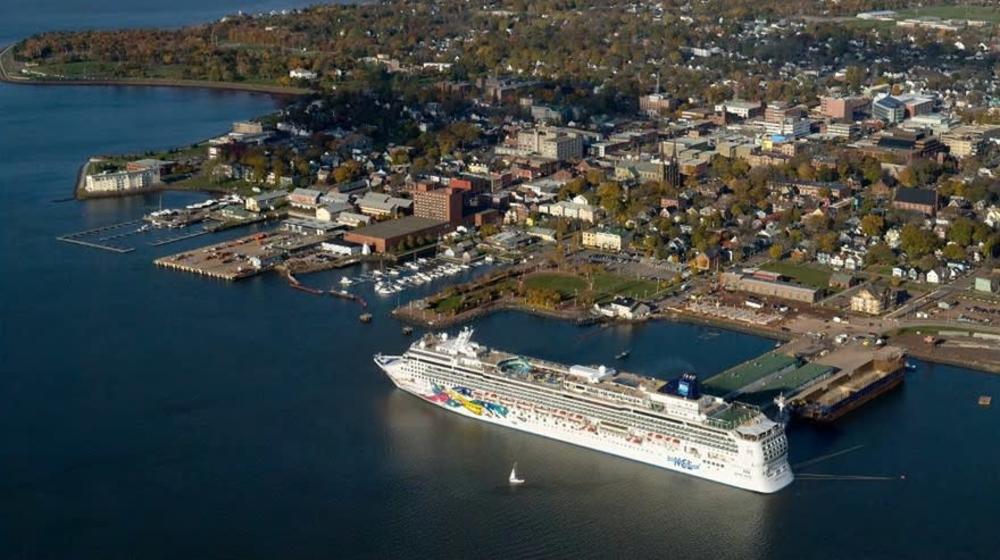Port Charlottetown Shore Power Infrastructure Development
Port Charlottetown Shore Power Infrastructure Development
Advancing a Zero Emissions Future at Port Charlottetown
Port Charlottetown is an essential engine of the Prince Edward Island (PEI) economy. In 2024, the Port welcomed nearly 152,000 cruise guests over 94 vessel calls as well as operations by cargo vessels bringing fuel, aggregate, and other bulk commodities to the province.
In alignment with the City of Charlottetown and the provincial government’s carbon reduction goals, Port Charlottetown seeks to reduce greenhouse gas (GHG) emissions associated with its operations. One critical initiative is the installation of shore power infrastructure. Shore power systems are a proven way to reduce in-port and near-port emissions of air pollution. Port Charlottetown, in cooperation with Maritime Electric, seeks to supply shore power to its facilities to reduce the environmental impact associated with its growing businesses.
What is Shore Power?
Cruise ship activities are an essential component of the Port’s annual business and a major contributor of economic and social benefit to the City of Charlottetown and PEI. Cruise ships run on-board power plants while docked at a berth. These hoteling operations are contributors to air pollution.
Shore power infrastructure (also referred to as cold ironing) enables ocean going vessels to turn off their engines while at berth and connect to the local electrical grid. In 2023, Port Charlottetown along with consultants Moffatt & Nichol and stakeholders Maritime Electric, the City of Charlottetown, and PEI, prepared and adopted a shore power master plan with the goal of extending this infrastructure to its two primary cruise berths. Resulting from a top-to bottom assessment of current and forecasted vessel operations, technology applications, potential installation sites, stakeholder interviews, and exploration of five options for infrastructure deployment, a singular project direction was finalized. The vision calls for on-Port implementation of shore power systems capable of supplying power to either or both (depending on power consumptive needs) cruise vessel berths. The system would be built to international IEC/IEEE 80005-1, -2 standards plus local code requirements including NEC, and as well as Canadian and Maritime Electric regulations.
Funding of planned shore power infrastructure is the subject of the Port’s application for support under Transport Canada’s Green Shipping Corridor Program (GSCP) and cruise industry backing vis-à-vis Environmental Sustainability Fee in the amount of $3.00 per passenger commencing the 2026 cruising season.
Given existing power distribution and available Port property for development, Port Charlottetown anticipates the system would be operational by Summer, 2027.
Visualization of Shore Power Infrastructure at Port Charlottetown

The Benefits of Shore Power at Port Charlottetown
Investment in shore power will result in meaningful reductions in emissions. When deployed at each of Port Charlottetown’s primary cruise berths, emissions are forecast to reduce by 89% in year 1 and 92% by year 25 over a no-build baseline scenario. As the Port is adjacent to the City, avoided emissions will directly benefit nearby residential, commercial, and recreational areas.
The successful development of shore power infrastructure at Port Charlottetown holds promise for Canada to host a network of green cruise ports along a single itinerary—Halifax, Charlottetown, Quebec City, and Montreal. Extending this green shipping corridor to New York equates to the possibility of cruise ships being able to connect to local electrical grids at all major homeports and ports-of-call along the nearly 1,500 nautical mile corridor by 2028/2029. This 1,500-mile cruise shipping green corridor and its respective shore power enabled ports will be the most complete of its kind in the Americas.
A Green Shipping Corridor Stretching from Montreal to New York
Our Commitment to Continued Stakeholder Outreach
Stakeholder outreach on shore power planning and development started in 2022 and included the City of Charlottetown, PEI, Maritime Electric, port users, regional port partners (e.g., Ports of Quebec, Halifax, et.al.), the Epekwitk Assembly of Councils, and others.
Once fully funded, Port Charlottetown commits to continual outreach with these stakeholders and the local community. For key outreach audiences listed above, updates will be provided at council, board, and other regularly scheduled meetings. For the public and other interested stakeholders, the primary method of dissemination will be digital through this project website—peishorepower.com—and Port Charlottetown’s website and social channels for design and construction updates, commissioning, and use. Hybrid stakeholder and community meetings will be held at project milestones to alert the respective audiences about project status updates.
Following project implementation, GHG emissions reductions (from monitoring) and other system benefits will be calculated and reported via these digital channels annually as a result of using shore power electrification for all users of Port Charlottetown. Post-construction information will also be shared to key outreach audiences listed above at council, board, and other regularly scheduled meetings.
Want to Learn More?
- For project inquiries, please contact:
- Mike Cochrane, CEO, Charlottetown Harbour Authority
- [email protected] | 902.569.3091
- To email the project team, please contact: [email protected]a
- To learn more about Port Charlottetown, please visit: www.portcharlottetown.com


